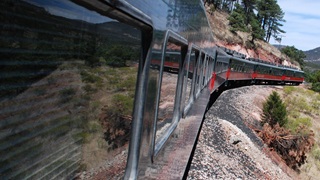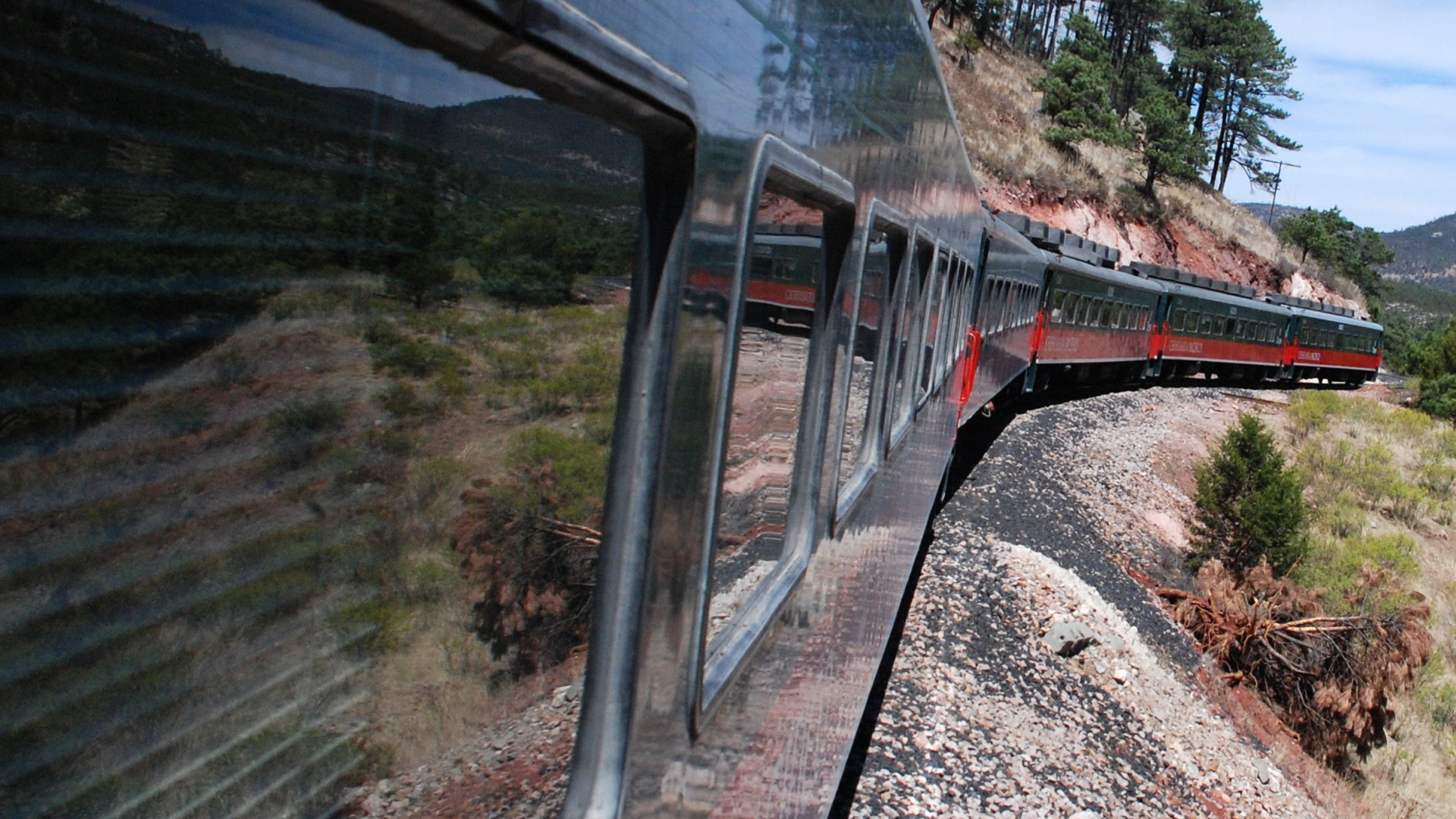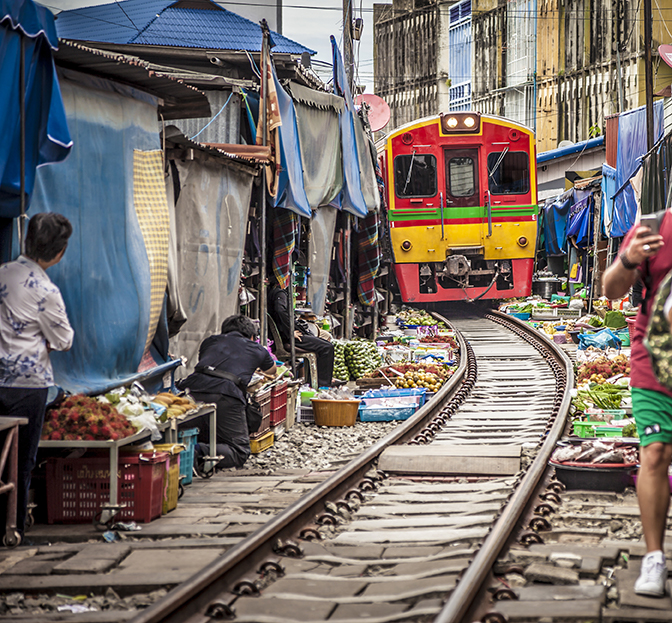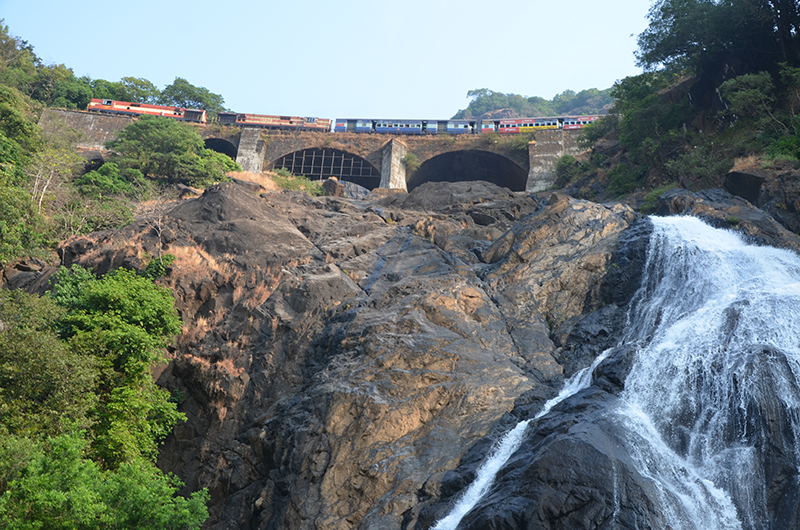
The guide
For travellers


'it passes through the shadowy dusk of the forest and lake country of Minnesota [and] you awake to the bright austere plains of North Dakota'
Seven writers : seven unforgettable journeys by train
By Yvonne Puig, Austin
My father never forgot a National Geographic story that he read in 1968, when we were kids. That’s why, years later, our family boarded the Chihuahua al Pacifico in Mexico and set out on a journey of more than four hundred miles to the Copper Canyon: the Barrancas del Cobre.
The railroad (now called El Chepe) advertised ‘world-class accommodations’. The reality was something quite different—and made the trip so much more memorable. Instead of a dining car, there was a car with seats removed and a hotplate, where a short-order cook warmed tortas with cheese. The ‘air conditioning’ meant open windows looking out on spectacular vistas. And the scenic car? A huge, cracked sun-roof.
We crossed huge cliffs and breathtaking mountains, disappeared into eighty-nine tunnels and passed by magnificent waterfalls.
We stopped in villages with weeping views of jagged, rough terrain. We saw the cliff dwellings where the Tarahumaras (the people who ‘live to run’) have survived for centuries. We glimpsed an older way of life.
The Copper Canyon is four times the scale of the Grand Canyon. As our train crawled along to arrive at the rim of the Canyon, with its four-hundred-feet drops, we heard the wheels squealing on the tracks down through all the open cars.
I long to return, but I think it is best I remember that priceless trip just the way it was, back then.
By Anna Wilkinson, Toronto
The Empire Builder runs daily between Chicago and the Pacific Northwest. Despite covering 2,200 miles in two days, it has plenty of fresh air and stretch stops. Leaving in the afternoon, it passes through the shadowy dusk of the forest and lake country of Minnesota, where cottagers wave from twinkling porches. You awake to a shocking contrast: the bright austere plains of North Dakota. Take in the view. Take it in again. By mid- afternoon, the landscape transforms, entering the Montana wilderness, home to the charming flag-stop Essex station (pop.~50). In season, a Trails & Rails National Park ranger boards to guide you through the rest of the journey, starting with an evening introduction to glaciology in the Glacier National Park Rockies. The train splits at night and, heading to Seattle, the final morning is spent hugging the shoreline of Puget Sound, scanning for whales and identifying peaks of the snow-capped Cascades. From the mayhem of Chicago’s Union Station to the elegance of Seattle’s King Street Station, from plains to mountains, lakes to sea: this is a journey of contrasts.
By Paul Baram, Sydney
The Grand Express is reputed to be the most luxurious Russian train operating on the St Petersburg to Moscow railway. When we booked our seven-hour journey, we had the choice of four types of VIP cabin: Premium, Grand, Imperial and Grand Deluxe! I was in Russia with my daughter on a heritage tour. My grandparents left Russia by train over one hundred years ago in a time of turmoil in the Russian Empire.
Embarking at Moskovsky Station, and with train staff standing to attention at each door of the train, we had a taste of the luxury to come. My meagre Russian language skills got a real workout as the cabin crew explained the breakfast menu and the do’s and don’ts of the bathroom and the fold-out beds.
We were gently rocked to sleep and awoke to a vista of forests, lakes and villages. Breakfast (eggs Benedict, yoghurt and fruit) was delicious. The countryside gave way to the Moscow suburbs of apartment buildings and we arrived refreshed at Leningradsky Station. My grandparents never knew such luxury in Russia.
By Robbie Pattemore, London
Jude and I always catch the sleeper trains from Bangkok down to the Thai islands. If you have the luxury of time, I’d recommend this an alternative to flying.
Our first time was in bunks with the masses but recently we’ve upgraded ourselves to a private cabin! Whatever the travel conditions, we always buy a bottle of Thai whisky, sit on our bed/bunk with the window open and watch the nightlife of the towns and countryside roll by while playing cards. The shops and bars that line the tracks in the various stops are so close that you can simply lean out from your cabin window and replenish your ice and mixer stocks. Not so lucky if you come to a halt opposite a dried fish stall.

At four in the morning they start to bring round a breakfast of omelettes and coffee. We get off the train an hour later and take a moto-taxi to the nearest port, where we jump on a fishing boat or a ferry for the last six hours of the journey.
By Nicola Liu, London
In the 1980s, when I lived in China, I went everywhere by train. The first time I went to Xinjiang it was because Urumqi was the end of the line, and I wanted to see what was there. I had no money, so I booked a hard seat for the four-day journey from Shanghai. I knew I would arrive in the cold winter of northern China. Someone lent me a Chinese peasant’s overcoat and I bought some dogskin knee pads in Shandong. I sat next to a woman whose only book was a small Chinese dictionary and whose only food was a sack of puffed rice; the train guard brought round a kettle of hot water, which my neighbour used to fill her enamel mug to soak the rice. I could have walked through to the dining car, past the hard berth and soft berth compartments, to eat my fill of steamed rice and a hot dish, but at some point the will to exert myself fell away, and I was too embarrassed to do more than watch the others squeezed in around me. At night, in the rain, I saw a fragment of the Great Wall outlined against the black sky and hills. Xinjiang is a place outside the reach of the Great Wall. The next day the train went through the Gobi desert forever, it seemed. I hadn’t realised it was a desert of stone. In the distance, coming closer, I saw the Tianshan mountains. I could barely walk when I left the train and barely bring myself to leave my fellow travellers, I felt such kinship with them. Later, after I had started to work in Xinjiang, the Urumqi–Beijing line became familiar to me; three days, a hard berth, a good book, a long, long journey that took me across northern China again and again, until I owned that journey. You can get the measure of a place if you go by train.
By Josh Bernstein, Austin
You’d be surprised at how pleasant a place the Toledo, Ohio Amtrak station was in 1997. Even at 2am, in the dead of winter, when it was mostly empty.
I had just driven a hundred and fifty treacherous miles, after working a shift waiting tables at a fondue place in Columbus. And I had another five hours to go by train to Chicago, where I would see a girlfriend I did not love.
In the anteroom, a grainy VHS copy of Arthur was playing on a burned-out tube TV. When the credits rolled, and up came its familiar theme song, I was almost in tears. Gezellig, the Germans would call it. Hygge to the Danes. We’d say ‘cozy’. But it was more than that. There’s a clarity and purpose to setting out on a journey. And the irregular hour, room, and movie all seemed to be telling me something.
Settling in, the train felt oddly antiseptic. I rested my head against the cold steel rail beside me and tried to sleep, tracking the rhythmic movement of the train.
By Jenny Gray, London
My fellow passengers on the Trans-Siberian Express included families going on holiday to Lake Baikal, Russian conscripts returning home, the unwell seeking medical treatment in Moscow, and a number of overweight women heading for a health spa on the shores of the Caspian Sea. At Ulan Ude, where the train picks up passengers from Beijing, we were joined by a British couple drowning their sorrows with Russian vodka after booking a non-existent Chinese package tour. Confinement to the limited space of the railway carriage for extended periods meant that station halts came to assume great importance, and the day’s activities were largely built around them. With only one train a day in each direction, shortages in the buffet car were put down to the local housewives who used the train as a travelling shop. Each time the departure whistle blew, twenty or thirty Russian women, dressed in thick winter coats and colourful headscarves, would alight from the train with whole salamis, jars of caviar and bottles of apple juice tucked under their arms.
By Aneesa Bodiat, Johannesburg (alumni)
I have gone by train from Cochin to Goa, thirteen long hours of cramped, cold discomfort. I have rushed from Mumbai to Surat on the ‘superfast’. I have luxuriated in the overnight sleeper from Gujarat to Jaipur, in a top bunk that wobbled. And, ever since The Darjeeling Limited, it has been a dream of mine to travel by train in the north of India. A few pointers: the air conditioning could be harsh; the tea will be milky; you would do well to have a Gujarati speaker. The views—could be grimy, could be amazing. Do you want some memories? Then try it.

First published in RE: issue 15 (2019). With thanks to Jenny Gray, freelance journalist and travel adviser.
© Norton Rose Fulbright LLP 2025